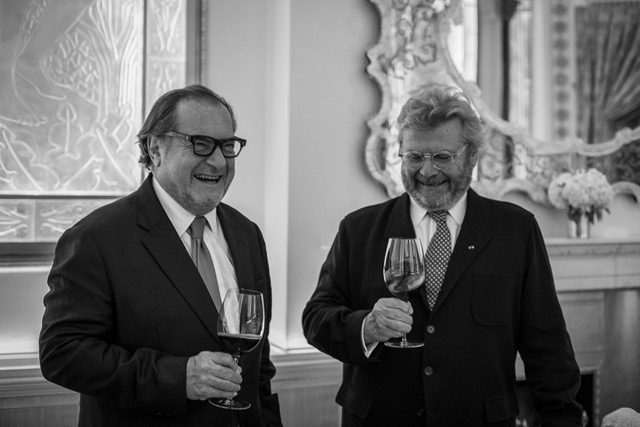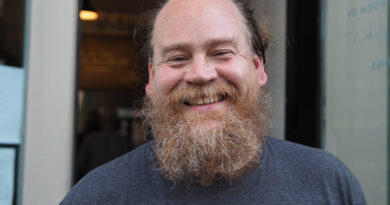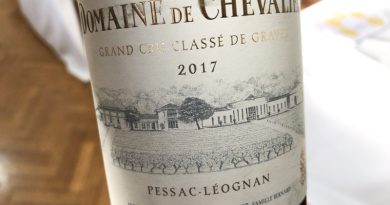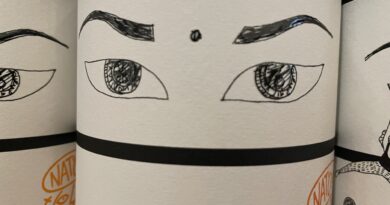Cartier, Cahors, natural wine and dead Brit bits
Alain-Dominique-Perrin and Michel Rolland talk Château Lagrézette to Lisse Garnett
Wines reviewed by Jamie Goode
Alain-Dominique Perrin is the man who tipped our tastes toward luxury. Credited with transforming Cartier into a global brand, he is hugely well known in his native France. Rugby player, art aficionado and A-list-celebrity mate, he’s known famed consultant winemaker Michel Rolland since the 70s. Having fallen for the ruined Château Lagrézette in 1979, he bought it in 1980, utterly ignorant of the attached plantation rights it had for AOP Cahors. Naturally, when it came to the vineyards he asked his travelling wine mate Michel to step in. Therein lie the roots of their winemaking partnership. Rolland and Perrin have worked together ever since, undertaking a gigantic amount of rebuilding and restoration. For Rolland the initial efforts were principally focused on the vineyards. For Perrin it has meant a twelve year mega-spend on restoring the house alone and untold millions on a new gravity fed cellar and winery, not to mention additional vineyards. (Pictured above: Rolland on the left, Perrin on the right.)
Alain and Michel enter and shuffle up on the maroon banquette with the impenetrable walls of Chateau Lagrezette behind them. The internet connection is rangy, forcing them into close proximity yet these two are in their own words ‘a couple’ having been close collaborators and friends for over thirty years. Successful, world famous, feted by presidents and kings, they are sitting before me like two giddy Head boys on a school bench. Alain appears strict yet approachable, Michel affable as Bagpuss. They’ve just been tasting the 2020 vintage.
Michel, are your winemaking protocols tailored individually to each client, or are there some more general approaches that you tend to adopt frequently with many? Is there a Rolland recipe’?
Michel Rolland: I’m sorry for your deception but there is no Rolland recipe and hahahaha I hope, I would like or I would wish Rolland style but not recipe. Because you know as I’ve mentioned before I make wine in 22 countries and I think if you make the wine the same, I’m born in Pomerol as you know, so if I do in Pomerol like I’m doing Malbec like at 2000m high in Argentina, there is something wrong for one or the other. So, it’s impossible to have a recipe, you have a philosophy, you have ideas on how to manage the grapes, on how to process the grapes but a recipe is almost impossible because the raw material we use to make the wine is so different. We have to adapt ourselves anytime we are facing the grapes in Argentina, in China, in Armenia, in Spain, in Italy or even in France of course. So that’s just a reaction regarding the raw material and in the end, we can use to make the wine. I try to be more adaptable as possible and sometimes is difficult to do that because you have to change your mind every month when you travel, not this year because I don’t travel this year regarding the problem, we are facing but. We have to change our mind but I love that, you know I come to Cahors, I cannot make the same as Merlot in Pomerol. I am going to California, I am going to South Africa, to South America, its different and that’s what I like really.
Has Argentina’s success with Malbec had a positive impact on the Malbec produced in Cahors?
MR: I’m involved in both. I’m in Cahors with Alain for a long time, almost thirty years, definitely I love Malbec and I thought at the beginning Malbec was absolutely good in this region, the viticulture is more important than anything else and after that we can speak about everything but the viticulture is important. When I came the first time (to Lagrezette) I said we have too much vigour and there is the solution in that, if Argentina improves their production, and the Malbec is definitely good in Argentina, they change their viticulture mind and they did much better in the last fifteen years than they ever did. Like in Cahors. That’s the same. And that’s why Cahors is successful today, it’s not successful enough because the wines are much better than the success is but that’s another problem, we need time for that. And that’s why Argentina is successful too. But viticulture is first one, after barrel, no barrel, whatever that’s just for the show.
ADP: I want to answer, I want to say one word, traditionally we are black wine and traditionally we speak about the black Malbec, which is different from the Malbec in Argentina, which is more kind of red Malbec, I think it is the only difference.
The other point I want to say is – he can’t say it but I want to say it – that Michel Rolland is behind the best Malbec of Cahors and behind the best Malbec of Argentina so this is why they are both good ok!
Alain where are your main markets? Is Cahors wine most popular in France? Does the name have currency in the UK and elsewhere?
ADP: It is true that we sell a lot of Cahors Malbec in France but mind you my export business is fifty percent. I sell a lot in Asia, Asia is a big market for us, we sell in England, we sell in America, we sell in Germany, we sell in many many countries except the South of Europe. We don’t sell in Italy and in Spain because they have plenty wine anyway, they don’t need us.
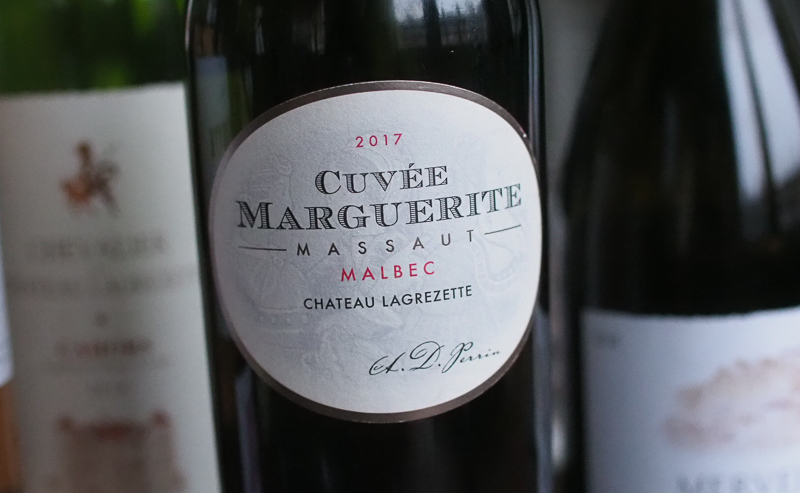
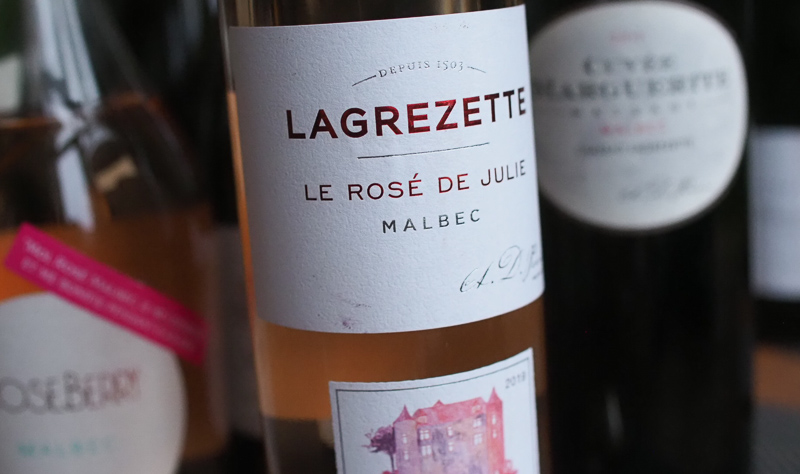
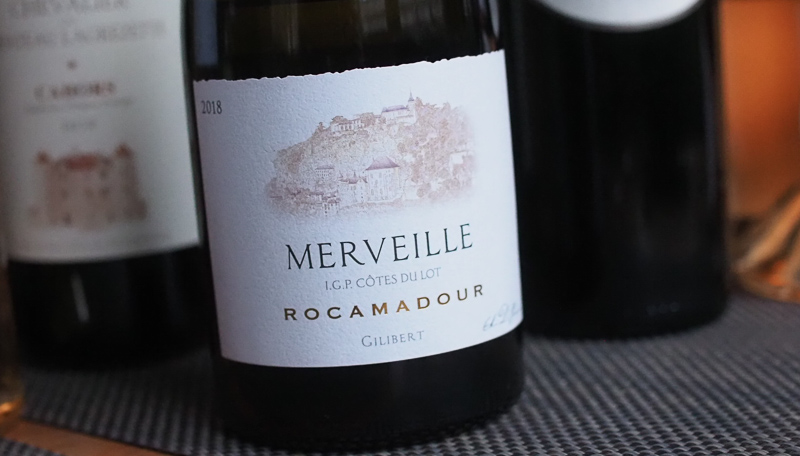

See Jamie’s notes on all wines pictured below 
You’ve been quoted in Sommeliers International as saying you were pointed at, even snubbed, when you had just bought the domain. Were you welcome here when you arrived?
ADP: Yeah, don’t forget they are rugby people, I am a rugby man, this is how I discovered Cahors by the way not through the wine but through rugby because I played here several times. I was playing with Paris and I went to have a match here. So, I feel very very happy in this country, I know them. They are a bit stubborn. They are a bit stubborn, it takes time, it takes more time here to change the rules, change the habits, to optimise the things than in the rest of France, they are a bit slow but it comes. And as Michel has said Malbec is improving more and more here and Malbec is moving in the right direction.
Michel, when you began working with Lagrezette thirty years ago there was no cellar and you had to vinify at the local co-op, what were the first changes you implemented?
MR: Well the first is definitely in the vineyard because everything is in the vineyard for to make wine. So, I remember we went to the vineyard, we walk, we go by car, we did everything in the vineyard because I have to know how the vineyard is and so we went there. When we come back, I told to Alain – You know we have a lot of work to do before to even speak about wine even. We have to produce the right grapes. Because without right grapes there is no oenologist. Even Michel Rolland is not working.
The grape is most important. And so, we began there and fortunately we had with us a fantastic guy, who passed away now (Monsieur Pradel a name from the area, from the South west) but from here. But as Alain mentioned with very hard head but this guy did amazing job in the vineyard and that’s where we improve the wine first.
After that we improve the cellar, we improve the tanks, we change the tank three times, we did all that we have to do to perform better but at the beginning – vineyard. I used to consult in 21, 22 countries in the world and every time we began in the vineyard, every time, only in the cellar, NEVER.
ADP: Amazing guy (Monsieur Pradel), the first time Michel Rolland came and he heard Michel say, you have to put the grapes down, you have too many grapes and after he came to me and he said Monsieur Perrin, I don’t think I will stay with you because your friend from Bordeaux he is throwing away the banknotes on the soil, on the ground!
I said but you must not worry it will produce more bank notes after ok.
MR: Hahahahahaha.
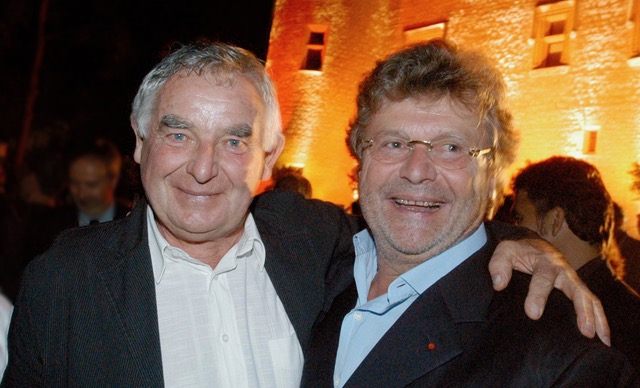
Like the castle?
ADP: It took twelve years to restore the castle. Don’t worry it is one of the major listed monuments in this area. It is a class A monument historique, you must come and see, it’s a nice piece of art.
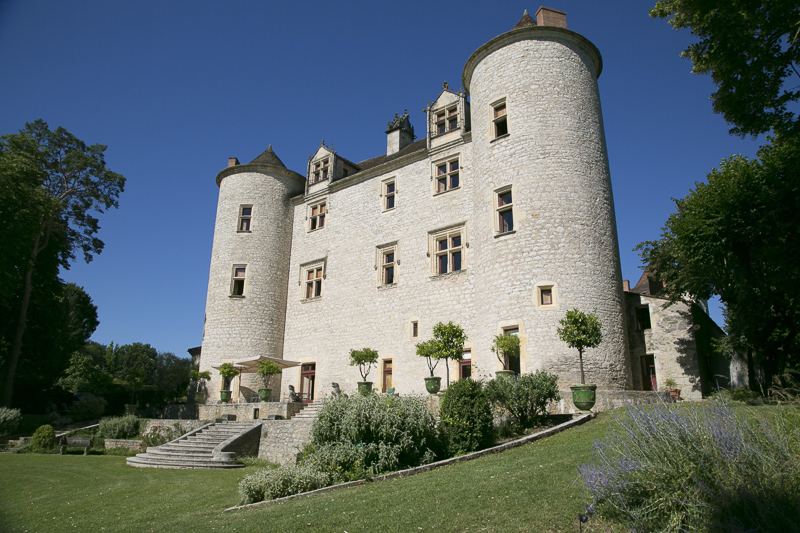
Lagrezette Castle is very romantic and I read that it was built on the site of a fortified house, are the thick walls and castellations an affectation or did they serve a purpose?
ADP: Sure because don’t forget that it was (built at) the time of the one hundred years war with you people. And you know don’t forget that south west today, south west of France is I would say, fifty percent English. The are still plenty English people living here, they have one magazine, two or three daily newspapers, I mean this is the English part of France and I love it.
You found an oubliette?
ADP/ OF COURSE! Of course we found an oubliette with bones, human bones, maybe BRITS!
MR/ hahahahahahahahahahahahahahaha.
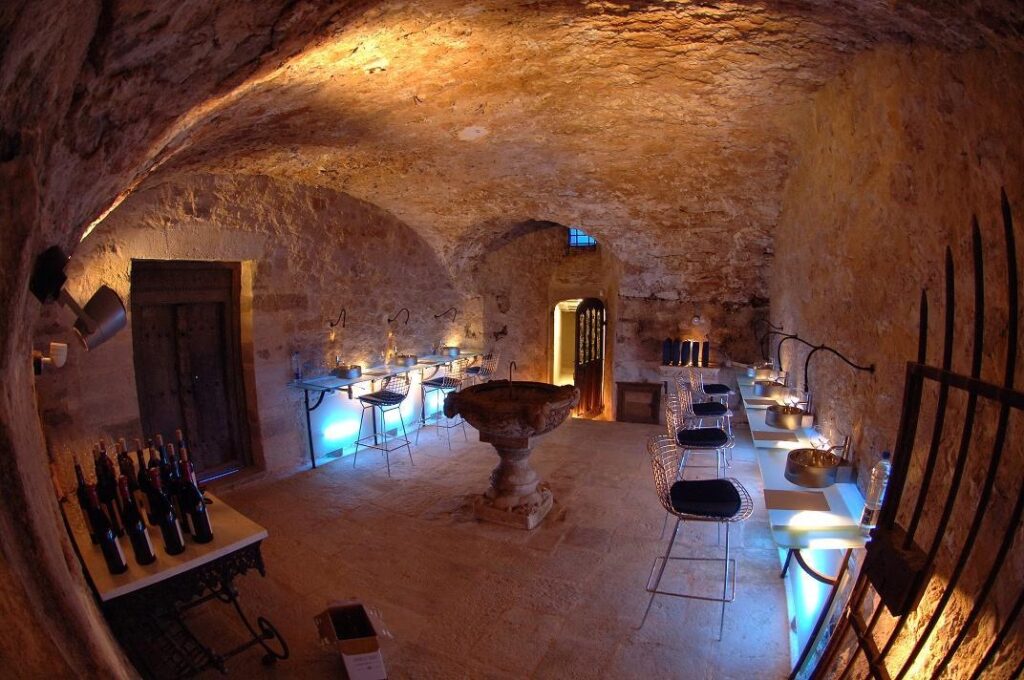
The underground tasting room at Lagrézette. It was here an oubliette containing human bones was found.
Michel what do you think of the trend of alternative élevage – bringing wines up in large format oak, concrete and terracotta, as opposed to stainless steel and small oak? Is this just a gimmick?
MR: Hahahahaha.
ADP: Nice question.
MR: Very good question. You know first of all, I am very open minded so I can do everything. I love stainless steel, I love concrete, I love terracotta, I love barrels of course. So that’s not a technical question for me, that’s just a philosophical thinking from the owner. If the owner wants terracotta, we do it in terracotta, if the owner wants concrete, we do it in concrete but it’s not the same, all are different. My main job is blending so what I love is to have concrete, stainless steel, terracotta, barrel, even big barrel, oak tanks and to blend altogether and to do the most intelligent blend I can do. That’s my job and I love to do that and I have nothing against nothing because anything is possible. But the guy saying I am just doing terracotta – I think it’s just a little bit in the cloud, but there is some gimmicks part in the middle. But it’s not bad, we can’t say it’s bad, nothing is bad.
Your Ch Lagrézette, Le Pigeonnier White Vision Viognier 2018 IGP Côtes du Lot has sired some exquisite reviews, Purple Pages reviewed the 2018 as ‘Tense, muscled, in that absolute-control-stillness of a predator holding for the perfect second. 18 points’. What does it take to produce wines at this level of quality?
MR: Rocamadour is very limestone soil, completely different to here (Lagrezette). The idea was to make something different, when we planted the vineyard, we never think the viognier was so expressive in this place, like always, only Lafite knows Cabernet Sauvignon is going well and Petrus is knowing merlot is going well. Rocamadour was quite new for us, it was a good surprise, we produce viognier grapes with very good viticulture, very expensive viticulture!
MR: I do not understand why but he is still my friend. And we are producing very good grape and almost fantastic wines, sometimes with small differences because the climate is continental climate and is not so easy to manage. We do not manage the climate, you know that, and so is not the same everywhere. But today with global warming is mostly favourable for us and we are producing years after years better and better wines because we have the good grapes. Vinification is not the problem that’s just technical.
And what do you both make of the natural wine movement? Has this had a beneficial effect more broadly in the wine world, with people picking earlier and adding less to their wines?
MR: We all love natural wine – obviously – but we all love natural wine until the wine is good, there is some people loving natural wine even if is BULLSHIT. That’s not my thinking. I love natural wine. I try to be natural as more as possible but until the wine is good. I don’t want to not use sulphur if the wine is bad to taste. My pleasure is to taste good wine, is not to taste whatever BULLSHIT wine. I am sorry but I am like this.
ADP: Absolutely and I come from that. I don’t want my wine to be fashionable for one or two or ten years. No. I want my wine to be Chateau Lagrezette wine. Since 1503 we have been making wine here, maybe before, we have the evidence dating back to 1503 (a copy of the picking register) but we know that the wine is older than that, we know that at Lagrezette we probably started doing wine in 1450. We were sending black wine to England and you used to blend yourself with the claret from Bordeaux.
Alain, the use of the adjective luxury to describe a product no longer has resonance, instead consumers want to feel they are getting more – an experience, authenticity and the very highest quality possible, do you agree?
ADP: Don’t forget my life story is with luxury, my life story is with fashion ok. And the only part of my life where fashion doesn’t mean anything is my wine business. Wine is not fashion. Wine is an art de vivre (the art of living). it’s an elegance, it’s about taste, it’s about food and I think that France is the country where food and wine became the most important part of their culture. So I belong to that, I don’t give a damn about the fashion in wine, now the fashion is bio, tomorrow it will be something else and yesterday it was something else and twenty years ago it was heavy barrels and now it’s a bit less barrel and a bit more whatever. I’m not following that.
With Michel, we are making Lagrézette wine with a very strong identity. We just tasted the 2020 two minutes ago and I think the most important thing is that we keep our identity strong. Like the best wine of the world. I don’t want to compare to Lafite or Petrus but I get the same results, I have the same marks from Parker. When Petrus had 96, I had 95 so I am not ashamed. This is the most important thing, we must keep our identity, we must be true to the consumer.
Alain, how long ago did you two Alpha males meet and did you lock horns at first – now you seem very comfortable with one another, were you always able to be direct?
ADP: Thirty-two years! Now we are a couple hahahahaha we have been working together thirty two years and not only do we work, we meet socially quite a lot and I’ve always respected Michel and the way he works, he told you, you can see he is a strong man…He is not a courtesan. And the result is there, Chateau Lagrezette, Pigeonnier, and all the products are famous wines, respected wines and that’s what I wanted to achieve.
It took us 30 years, 32 but we are there, we are there.
| Jamie Goode tastes a selection of wines from Lagrézette and delivers his verdict |
| Lagrezette Merveille Rocamadur Gilibert 2018 IGP Côtes du Lot, France 15% alcohol. This is rich and peachy with bold apricot fruit. It’s concentrated and dense, with some sweetness from the fruit and the alcohol. This is sweetly fruited with amazing depth to the fruit. Really exotic and expansive with some buttery hints and a touch of brioche. Opulent but classy. 93/100 |
| Lagrezette Le Pigeonnier White Vision Viognier 2018 Côtes du Lot, France 15% alcohol. This comes from Lagrezette’s Rocamadour vineyard, and it’s from an older (14 years) plot on clay/limestone soil. Whole-bunch pressed to small oak for fermentation, then aged on lees for 9 months. There’s no doubt about the varietal origin of this wine: it shouts Viognier, with apricot and peach, as well as some fine spicy frills and a touch of coconut and fennel. The palate is bold and intense, but also broad and quite fat. It has the smooth, almost stuctureless mid palate that Viognier is prone to, with some peach kernel (I love this in Viognier), apricot and marmalade notes, but also a slightly warm, sweet alcoholic undercurrent that veers off into celery salt on the finish. There’s a lot to like – even love – about the wine, but it does feel like in order to get all this richness of flavour, the sugar ripeness (and hence alcohol level) may have been a compromise too far that stops it short of the greatness its price tag implies. 93/100 (€70 cellar door, UK retail c £90) |
| Lagrezette Le Rosé de Julie Malbec 2019 Côtes du Lot, France 12.5% alcohol. Pale in colour, this is really stony and bright with some redcurrant hints and nice pear and green apple fruit, with some fennel and herb notes and a lovely texture. There’s a crystalline brightness here, with a touch of mandarin, too. Fresh and vital. 91/100 |
| Lagrezette by B Perrin Roseberry Rosé Malbec 2019 Côtes du Lot, France 12.5% alcohol. This has some sweetness with rounded, slightly honeyed notes as well as pear, apple and spice. There’s a nice texture here and there’s even a touch of Turkish delight. Has an ease to it: very attractive. 89/100 |
| Chevalier du Château Lagrezette 2018 Cahors, France 14% alcohol. This is a smooth, ripe expression of Cahors, with some silkiness and polish, but there’s also a lovely chalkiness and a bit of graininess. There’s some sour cherry and black plum fruit, with a nice lushness, but it never strays into over-ripe territory. There’s some seriousness, though: after two days it is perhaps even better, with the structure more pronounced. There’s a little oak here, but it’s really well integrated. 92/100 |
| Château Lagrezette Cuvée Marguerite Massaut Malbec 2017 Cahors, France 14% alcohol. This spends 16 months in new French oak barrels. It’s a really stylish interpretation of Cahors, with sweet blackcurrant and black cherry fruit meshing well with dark, savoury gravel and wood spice notes, with well integrated oak, and some notes of mint and incense. This is a very sophisticated, refined, wood-influenced expression of Malbec. It shows concentration, freshness and a nice savoury foil to the dense fruit. The barrel character makes its presence felt, but it’s a brooding, structural presence and I think this wine has lots of potential for development. 94/100 |
Find these wines with wine-searcher.com

